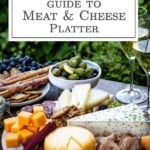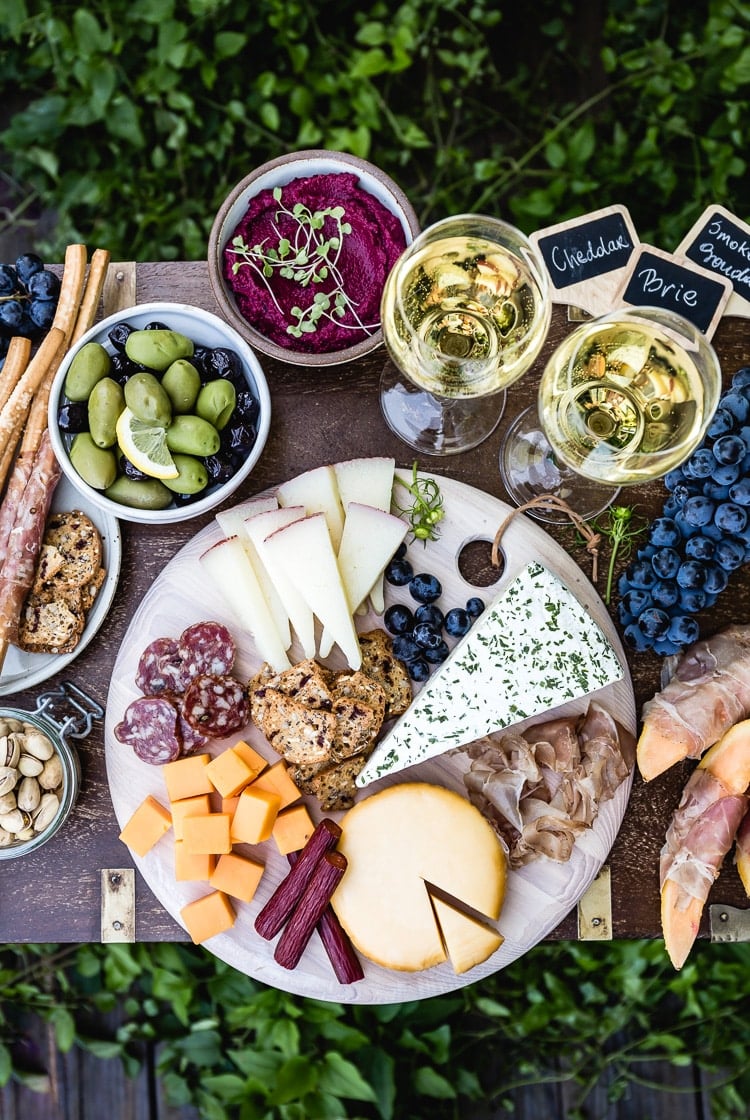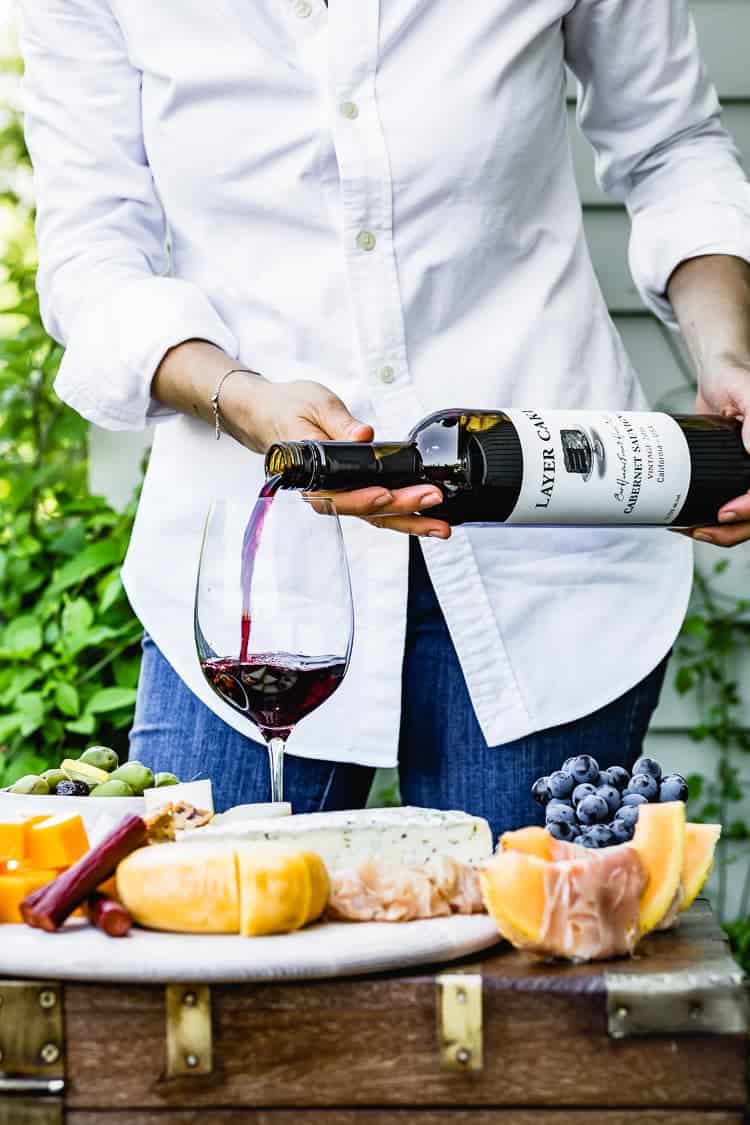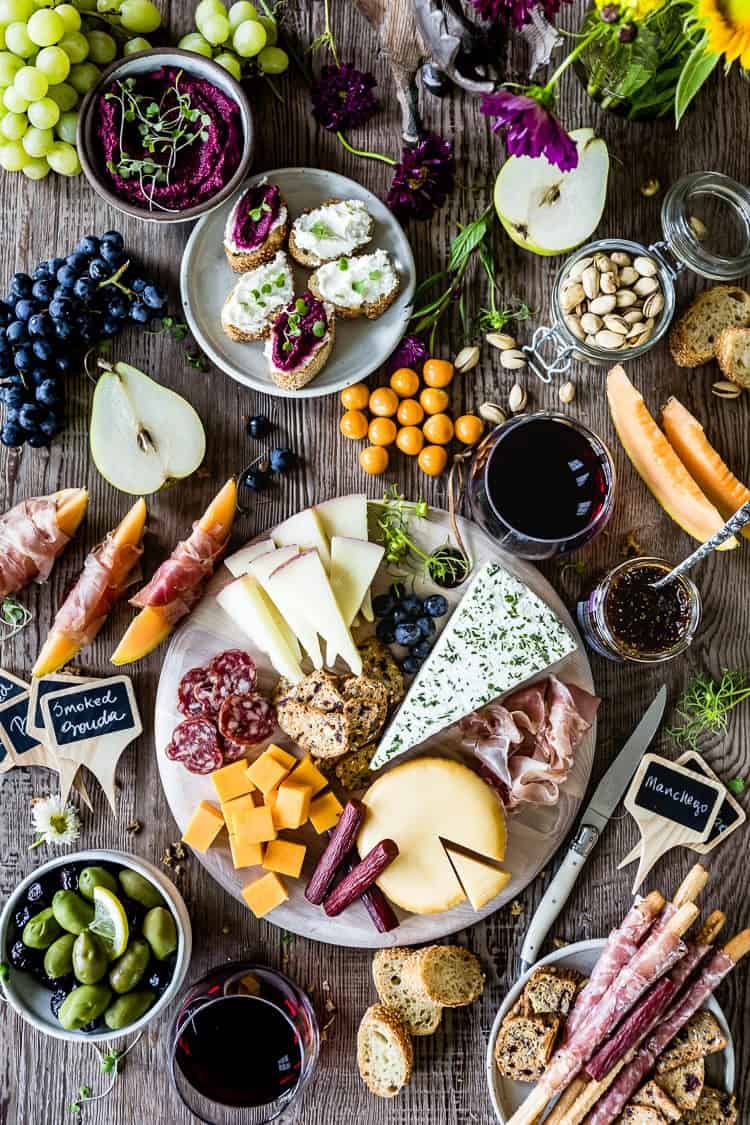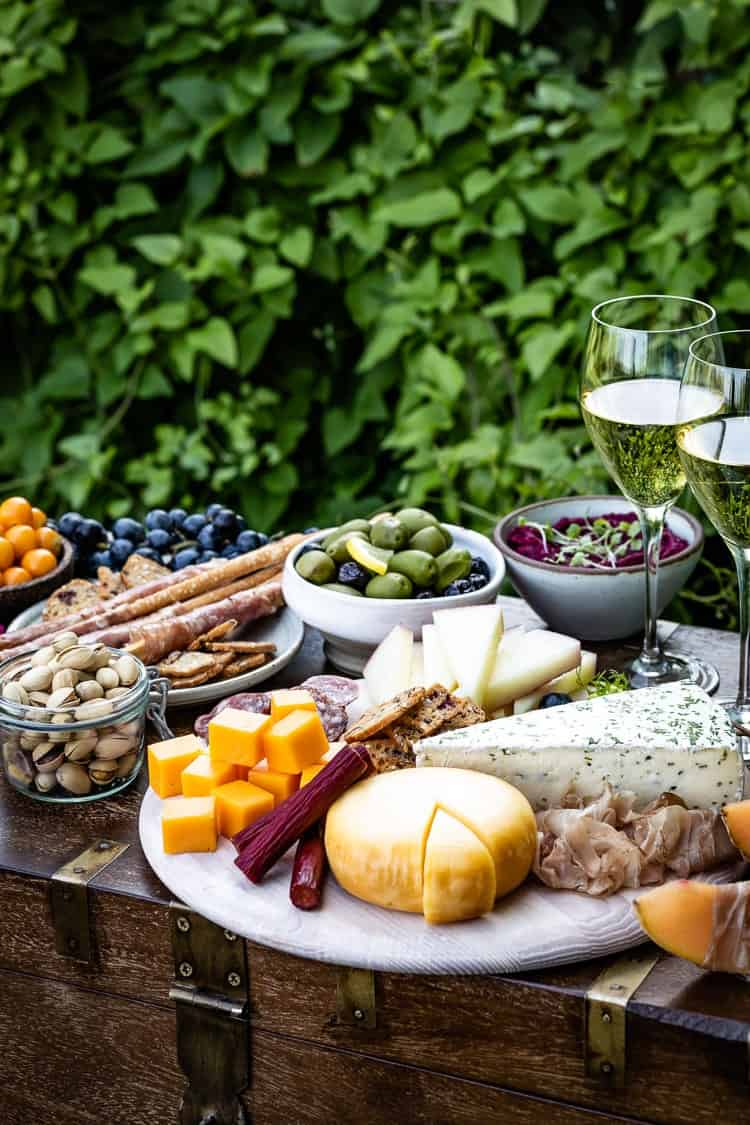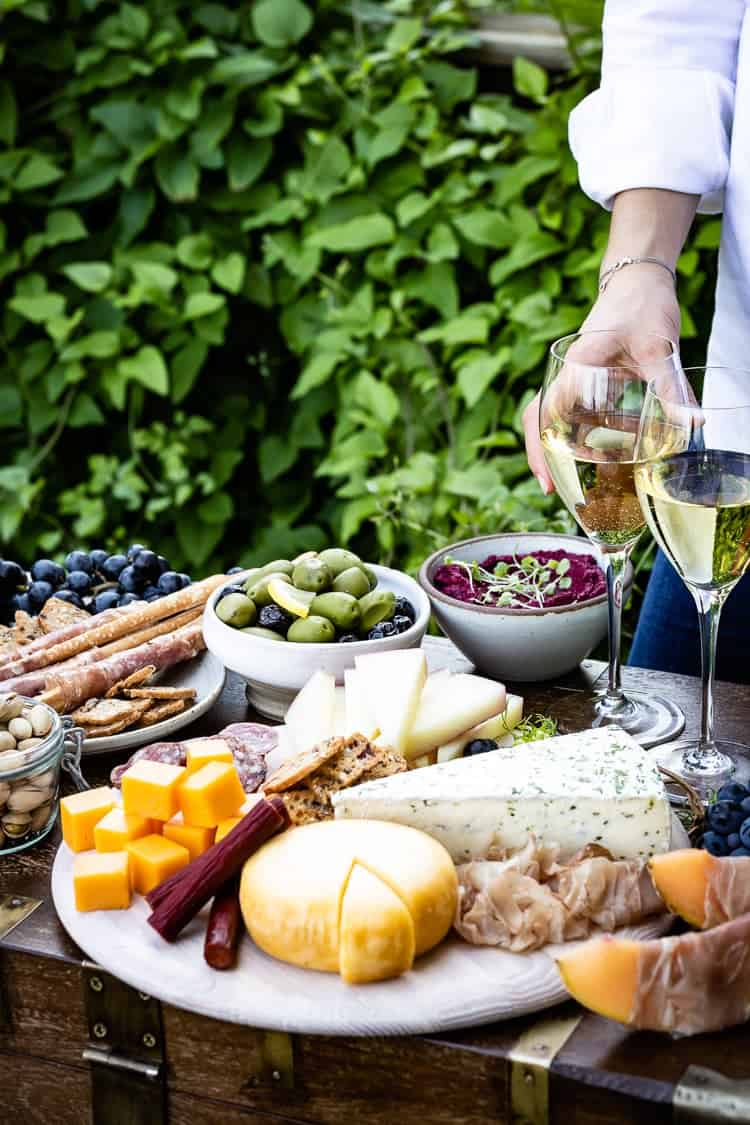There is no doubt that winters are long and brutal in Vermont. To be honest, just the thought of wearing turtlenecks and boots in a few short months give me the chills. However, after almost 2 years of calling this beautiful state home, I know one thing to be true: The chance to experience the beauty of the transition from summer to fall is worth every minute of those merciless cold months. What I love about it the most is that the days are still long enough to enjoy the beauty of the foliage with cooler (but comfortable) temperatures that makes it a joy to be outdoors. Gatherings with friends and family become a frequent occasion before we head inside for the colder months. In the next couple of weeks, a few friends will be coming over from Atlanta to join us witness the season change. As you can imagine there is a quite a bit of entertaining in my near future. And when it comes to easy outdoor entertaining, my go-to set up has always been a beautiful meat and cheese platter. That is why today I thought I could share my tips on how to make the best cheese and meat platter with the hopes of giving you some party tray ideas as we approach the holiday season. Additionally, since I always serve it with a variety of wines, I partnered up with Layer Cake wines to share some of my wine, charcuterie, and cheese pairing suggestions to help you as you prepare your own. I’ll be utilizing these tips for some light entertaining and gathering with friends, but be sure to bookmark this post to be used for dinner party tips, pre-holiday celebrations, and more!
What is a Charcuterie Board?
Did you know one of the most frequently asked questions in Google on the subject is what is a meat and cheese tray called? Knowing that I think it is important to address what I would name such an arrangement. I am sure you have seen such a party platter being sold in supermarkets during the holidays. While they refer to it as “Meat and Cheese Platter” or “Meat Cheese Tray”, the most commonly used name is Charcuterie Board. According to the definition on Wikipedia, Charcuterie is a French term for a branch of cooking devoted to primarily pork meat products. It was originally intended as a way to preserve meat before refrigeration was invented. Nowadays, with the increased availability and popularity of cured meat (aka cold cuts) made from various meats, the name Charcuterie is used as a general term for all kinds of preserved meat including bacon, ham, confit, salami etc. And if this word is new to you, the correct way to pronounce it is “shahr-ku-tuh-ree”. So, in light of this information, what we refer to as Charcuterie Board here is a board prepared with various cold cuts (cured meat). Nowadays, most Charcuterie Boards are also arranged with various cheeses, dried fruit, nuts, crackers, and served as an appetizer.
How To Make The Best Meat and Cheese Tray
I don’t know about you, but I believe a charcuterie and cheese board is much more than throwing a few pieces of cheese and cold cuts on a board and serving it with crackers or bread. While that is certainly acceptable, I look at it as a form of art and an opportunity to feed the eyes of your guests before you satisfy their palates. With that being said, choosing the right combination of wine, cheese, meats, crackers, and other accompaniments takes a little bit of planning, but hopefully, with my tips, it will be an easy one and you will master the art of preparing a gorgeous meat and cheese tray for your guests.
Pick your cheese
Lucky for us, nowadays most supermarkets have a section for a variety of cheeses that goes beyond your usual provolone, cottage, mozzarella, and cheddar cheeses. When it comes to picking the cheese for my meat and cheese tray, I think about 2 things:
- Taste and Texture: It is no secret that cheeses come in a variety of tastes and textures. When setting my platter, I always go for odd numbers as I find that to be most visually appealing. I also love to choose a different texture for each type of cheese I am placing on my cheese board. Below are my favorite ones:
Aged: Gouda, Sharp Cheddar, GruyereSoft and creamy: Brie, Camembert, Epoisses, Burrata, Fresh Buffalo MozzarellaCrumbly: Goat and Feta CheeseFirm: Parmigiano Reggiano, Manchego, GoudaSmoked: Smoked Gouda, Provolone, and CheddarBlue cheese: Gorgonzola, Stilton, Roquefort
Each of these cheese varieties has its unique flavor, texture, and smell. I personally do not mind smelly cheeses but I know that some people don’t care for them. That is why, if you are serving new friends (or people whose preferences you are not familiar with), I recommend staying away from smelly cheeses like Epoisses, Stilton, and Gorgonzola. 2. Wine and Cheese Pairing:Another important factor when picking cheese for your cheese and meat platter is wine pairing. Similar to the cheese, I try to stick to odd numbers when it comes to types of wine I serve. For my Ultimate Fall Cheese and Meat Platter, I picked Layer Cake Wines’ Shiraz, Malbec, and Chardonnay (but would also recommend their Cabernet Sauvignon). I find their wines to be richly layered and full-bodied. Additionally, they take pride in creating and curating wines by way of cultural immersion with one wine team that travels the world, carrying out harvests and making wines inspired by each region’s culture and people. Below are a few of my favorite wine and cheese pairings to get you started:
Malbec (chocolate tones): Sharp aged cheddar and aged ManchegoShiraz (cocoa and dark fruit flavors): Aged Jack and smoked GoudaChardonnay (clean, crisp fruit flavors): BrieSauvignon Blanc (citrus notes): Soft cheese like Mozzarella, Burrata, cream cheese or firm cheese like GruyerePinot Noir (light to medium-bodied): Manchego, Fresh Sheep’s Milk CheeseCabernet: Cheddar, Smoked Gouda, and sharp cheeses like Irish Dubliner
In my meat and cheese platter, I paired my wine with Brie, smoked Gouda, sharp Vermont Cheddar, and Manchego. The bold yet smooth and richly flavored taste of Layer Cake Wines paired perfectly with these cheeses.
Pick your meat (aka charcuterie)
You might ask, what does Charcuterie mean? It is the French term that is used for cold cooked meats collectively. Also, stores that sell cold cooked meats are called Charcuterie. When picking meats for a charcuterie board, I always go with the equal number of cheeses I used. In other words, if I use 3 types of cheeses I pick 3 types of meats. Below are a few of my favorite charcuterie meats list:
Dry Cured Salami: Made of beef or pork and mostly air driedProsciutto: Italian Dry Cured HamSopressata: Italian Dry SalamiMortadella: Italian Sausage
Last but not least, I usually include bite sized beef, turkey or pork jerky. Some people call jerky, “The American Charcuterie” and if you have ever had one you know how delicious it is.
Crackers and bread
I think we all can agree that you need a vehicle to get all this goodness into your mouth. That is where crackers and bread come into play. Thankfully, even in our small town, our grocery stores offer a variety of crackers and breadsticks to choose from. I am big fan of gourmet crackers that has sweet and nutty notes to them, but feel free to choose whatever you prefer. In terms of bread, I love a loaf of crusty French baguette because it offers the perfect portion size after it is sliced.
Other Charcuterie Board Ideas
In addition to variety meats and cheeses, I use a few other accompaniments to add-on and balance the layers of flavors in my charcuterie and cheese board. Below are a few of my go-to accompaniments:
Sweets: To balance all the salty and umami flavors provided by cheese and meats, I use sweet condiments like fig jam (or other seasonal preserves), local honey (with the comb), and fresh fruits and veggies in season. I love that sweets not also “sweeten” the board and mellows the flavors, but also add color making it visually impressive. Additionally, sweet additions allow me to make it seasonal.As you can see in these cheese platter images, I went grapes, kumquats, pears, and fig preserves as I was going for more of a fall theme.Crunchy: A handful of nuts are good for adding crunch and making the meat and cheese tray look full and abundant. I love pistachios and Macadamia nuts, but you can use any nuts you like. Or if you have the time, make my Spicy Candied Nuts for a next-level delicious nut spread.Olives and Pickles: Though they are savory, I think the tartness coming from olives and pickles are always welcome on a charcuterie and cheese board. I usually go for a mixture of black and green olives and cornichon, but feel free to serve whatever olives and pickles you like.Dips: If you have time, feel free to make a few dips (enhanced with fresh herbs) to add color and variety to your spread. I usually go with beet or Homemade Mediterranean Hummus and Roasted Red Pepper and Walnut Dip. Served with cheese and crackers, they are great if you are serving a crowd.The Company: The best part about creating a Meat and Cheese platter with perfect wine pairings is sharing it with your friends, family, neighbors, etc. and equally good conversation.
How To Arrange a Meat and Cheese Platter
Before I let you go, I wanted spend a few minutes and talk about the aesthetics of putting together a few cheese and charcuterie board. While there are endless possibilities, below are a few things I learned over the years of creating my own cheese trays:
What to serve your cheese and meat on?
I usually use a wooden cutting board, rustic wood cheese plate, wooden lazy susan, or a pre-cut marble to set it all up. If you are serving to a large crowd and those options are too small, you can also get a piece of wood cut to your liking at your closest hardware store and use it as your backdrop.
In the past, when I used pre-cut wood I covered it with parchment paper before I placed the cheese and meat on top. Since the whole board was covered with all the goodies the parchment paper was not visible. Alternatively, you can use food-safe finish to paint the board.
What is the best portion per serving?
My rule of thumb when it comes to cheese and charcuterie tray is 2 ounces of meat and 2 ounces of cheese per person. Since it is usually served as an appetizer and other accompaniments like fruit, nuts, bread, crackers, etc. are also served, I think 2 ounces of each is a good starting point.
How far in advance it is best to set up the cheese and meat platter?
The answer to this question depends on the weather (if you are serving it outside) or the temperature of the room you are serving it in. However, if you are serving it in room temperature or not-so hot outdoor temps, I recommend setting it up 20-30 minutes before your guests arrive.
Alternatively, if your fridge has enough space to accommodate a big cheese board, you can arrange the meat and cheese and cover it tightly with stretch film a few hours before serving. This way, right before you are ready to serve you can add all the other goodies onto your board.
What is the best way to serve cheese?
When it comes to cheeses, I do my best to make sure that they are finger-food friendly. In other words, I want my guests to be able to easily pick it up without needing a utensil or with the help of a toothpick. For that reason, if the cheese is firm I make sure to slice it thinly or cut into smaller bite-size cubes.
If the cheese is a soft spreadable cheese, then I make sure to place a cheese knife alongside so that my guests can easily spread it on their crackers or bread.
When you are placing the cheese on the platter I recommend making sure to leave room on each side of the cheese so you alternate the cheese with meat and fill in the gaps using small fruit, nuts, and crackers to make it look full.
On a final note, cheese taste best when it is served at room temperature so I recommend taking it out of the fridge 10-15 minutes before serving.
What is the best way to serve charcuterie?
You can certainly arrange the meat alongside the cheese, but if you don’t mind getting a little creative, you can also wrap fruit with some of these cold cuts.
As you can see in the pictures, I wrapped sliced cantaloupe with a few thin slices of prosciutto and breadsticks with soppressata. You can change up the fruit with whatever is in season to add color and sweetness to your cheese board.
A carefully curated meat and cheese platter is an easy, yet elegant way to turn an otherwise not-so-exciting appetizer to a gourmet dish that is delicious and visually appealing. So next time you are entertaining, treat your guests with a combination of artisanal craftsmanship and global flavors all in the form of meat and cheese. And while you are at it, be sure to pick up a few bottles of Layer Cake wines to enrich the experience and wow your guests.
WANT MORE CHEESY GOODNESS? Check out my Best Goat Cheese Recipes for more ideas.
